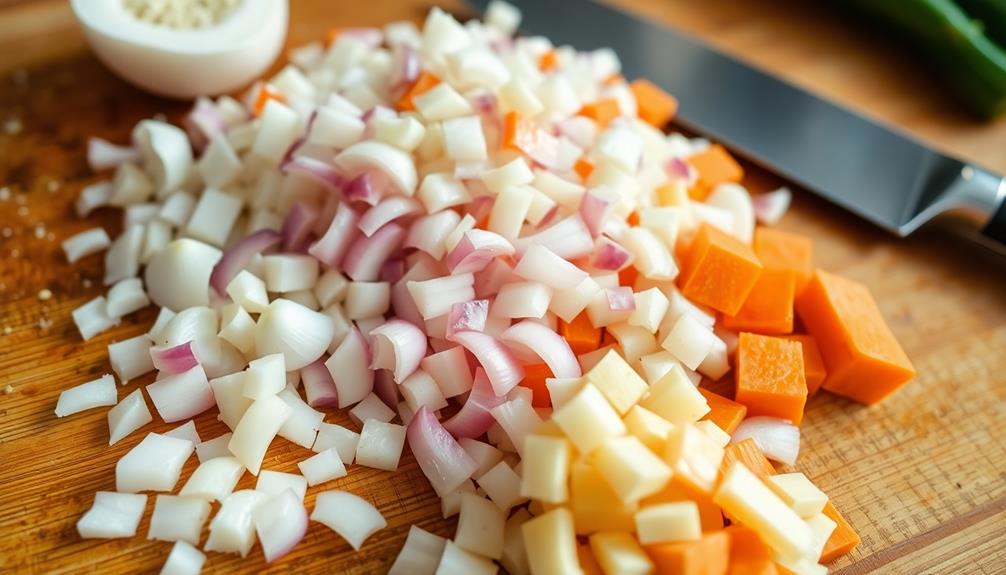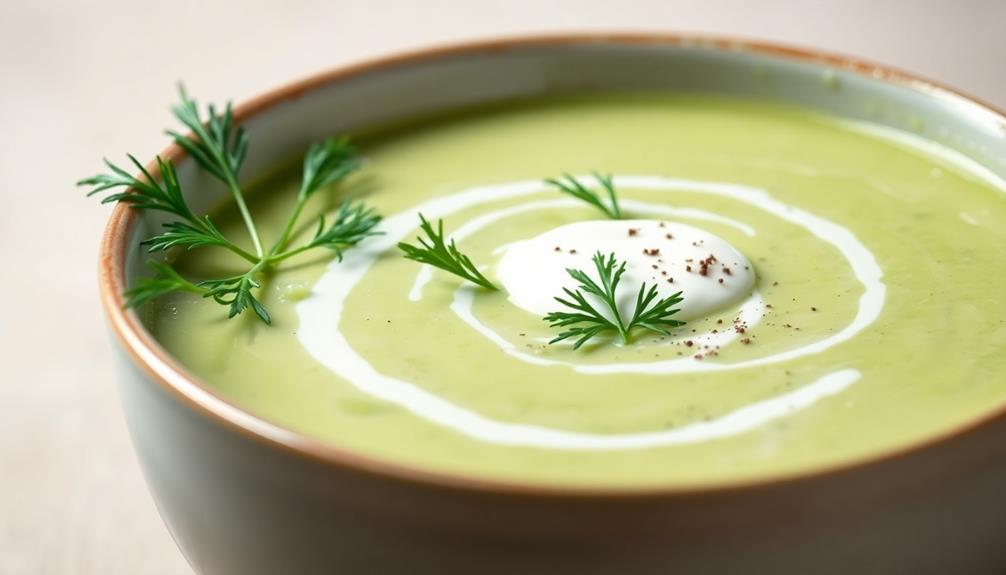Tomato soup's rich history and evolution have cemented its status as a beloved classic. Starting from humble origins in 16th-century Mediterranean cuisine, this comforting dish has captivated palates worldwide. Whether you prefer it smooth and creamy or chunky and rustic, the recipe is endlessly customizable with aromatic vegetables, high-quality tomatoes, and optional additions like cream or herbs. Beyond its delicious flavor, tomato soup offers nutritional benefits, including vitamins, antioxidants, and fiber. With so many ways to enjoy this versatile soup, it's no wonder it continues to delight and nourish. Discover the secrets behind crafting the perfect tomato soup experience.
Key Takeaways
- Tomato soup is a classic comfort food with origins tracing back to the 16th century when tomatoes were introduced to Europe from the Americas.
- The recipe can be customized to preference, yielding a rich, flavorful soup that is suitable for year-round enjoyment.
- Key ingredients in tomato soup include olive oil, onion, garlic, canned tomatoes, and broth, with optional additions like heavy cream or half-and-half for creaminess.
- Preparation involves sautéing aromatics, adding crushed tomatoes, simmering to develop flavors, and optionally blending for a smooth texture.
- Tomato soup is a healthy choice, being low in calories, rich in vitamins and antioxidants, and high in fiber, with the ability to be paired with various proteins.
History
Tomato soup's origins can be traced back to the 16th century, when the tangy fruit was first introduced to Europe from the Americas. Curious cooks in Italy and Spain began experimenting with this new ingredient, creating hearty stews and braises that combined tomatoes with local herbs, vegetables, and proteins.
The tomato's versatility and flavor soon made it a staple ingredient across the Mediterranean, much like in traditional dishes such as Cacciucco, which showcases the use of fresh ingredients in coastal cooking.
As tomatoes gained popularity, recipes for tomato-based soups emerged, showcasing the ingredient's ability to create a rich, comforting dish. These early versions were often thick and chunky, relying on slow-simmered tomatoes to develop their signature taste.
Over time, tomato soup recipes evolved, becoming smoother and more streamlined, making them easy to prepare and enjoy.
Today, tomato soup remains a beloved classic, cherished for its classic flavor and ability to warm the soul. Whether enjoyed on its own or paired with a grilled cheese sandwich, this timeless dish continues to delight taste buds around the world.
Recipe
Tomato soup is a classic comfort food that can be enjoyed year-round. This recipe yields a rich and flavorful soup that's perfect for a cozy meal.
To begin, gather your ingredients and prepare your workstation. Tomato soup is a versatile dish that can be customized to suit your personal preferences. Whether you prefer a smooth and creamy texture or a chunky and rustic style, this recipe can be easily adapted to your liking.
Ingredients:
- 2 tablespoons olive oil
- 1 large onion, diced
- 3 cloves garlic, minced
- 2 cans (28 ounces each) diced tomatoes
- 2 cups vegetable or chicken broth
- 1 teaspoon dried basil
- 1 teaspoon dried oregano
- Salt and pepper to taste
- Heavy cream or half-and-half (optional)
In a large saucepan or Dutch oven, heat the olive oil over medium heat. Add the diced onion and sauté until translucent, about 5-7 minutes.
Add the minced garlic and cook for an additional minute until fragrant.
Pour in the canned diced tomatoes and the vegetable or chicken broth. Stir in the dried basil and oregano.
Bring the mixture to a simmer and let it cook for about 20 minutes, stirring occasionally, to allow the flavors to meld.
For a smoother texture, use an immersion blender or carefully transfer the soup to a regular blender and blend until desired consistency is reached.
If you prefer a chunky soup, you can leave it as is. Season with salt and pepper to taste.
If you want a creamier soup, you can stir in a touch of heavy cream or half-and-half at the end.
Serve the tomato soup hot, garnished with fresh basil or croutons if desired. Enjoy!
Cooking Steps
First, dice the onions, garlic, and carrots into small pieces.
Then, sauté the vegetables in a bit of olive oil until they're nice and soft.
Finally, add the crushed tomatoes and let the soup simmer until it's slightly thickened.
Don't forget to stir in some creamy milk or rich cream at the end for a velvety finish.
Step 1. Dice Onions, Garlic, and Carrots

Next, you'll want to dice the onions, garlic, and carrots. Start by peeling the onions and cutting them in half from top to bottom.
Lay the halves flat on the cutting board and make thin, even slices. Carefully stack the slices and cut through them perpendicularly to create small, uniform diced pieces.
For the garlic, simply peel off the papery skin and mince the cloves using a sharp knife. Make sure to rock the blade back and forth, applying gentle pressure to finely chop the garlic.
Finally, peel the carrots and slice them into thin coins. Stack the carrot slices and cut them into matchsticks, then dice them to create small, evenly-sized pieces.
Be mindful of your knife skills, taking care to keep your fingers curled under as you dice the vegetables.
The goal is to end up with a flavorful mirepoix – a classic combination of diced onions, carrots, and celery that forms the aromatic base for many soups and stews.
Step 2. Sauté Vegetables in Olive Oil

After dicing the onions, garlic, and carrots, heat a generous drizzle of olive oil in a large pot or Dutch oven over medium heat.
Once the oil is shimmering, add the prepared vegetables and sauté, stirring occasionally, until they're softened and starting to caramelize, about 8 to 10 minutes.
The aromatic blend of onions, garlic, and carrots will fill your kitchen with a tantalizing scent, signaling that the base of your tomato soup is coming together.
As the vegetables cook, their natural sugars will begin to concentrate, adding depth and sweetness to the soup.
Be sure to scrape up any browned bits from the bottom of the pan – these caramelized bits are packed with flavor.
Adjust the heat as needed to prevent burning.
Once the vegetables have reached the perfect level of tenderness and color, they're ready to move on to the next step in crafting your homemade tomato soup.
Step 3. Add Crushed Tomatoes

Next, add the canned crushed tomatoes to the sautéed vegetables. The bright, juicy tomatoes will add a delightful burst of flavor to your soup.
Gently pour in the tomatoes, making sure to scrape the sides of the can to get every last bit. The tangy, tomatoey goodness will instantly fill your kitchen with a mouthwatering aroma.
Stir the tomatoes into the vegetables, blending the flavors together. You'll want to let the mixture simmer for a few minutes, allowing the tomatoes to break down and infuse the broth.
Keep an eye on the pot, stirring occasionally, until the soup reaches your desired consistency. The vibrant red color and thick, creamy texture will have your taste buds dancing with anticipation.
Now that the tomatoes are incorporated, you're one step closer to enjoying a comforting bowl of homemade tomato soup.
Step 4. Simmer Until Slightly Thickened

Once the crushed tomatoes have been added, let the soup simmer gently for about 10-15 minutes. This allows the flavors to meld and the consistency to thicken slightly.
You'll know it's ready when the soup has a slightly more velvety texture and coats the back of a spoon. Don't let it boil vigorously, as that can make the tomatoes taste bitter. Instead, maintain a gentle bubble, stirring occasionally to prevent sticking.
As the soup simmers, the liquid will reduce, intensifying the tomato flavor and creating a rich, soothing broth. You can even test the thickness by dipping a wooden spoon into the pot and seeing how readily the soup drips off.
When it's reached your desired consistency, it's time to move on to the next step. Get ready to serve up a steaming bowl of comforting tomato goodness!
Step 5. Add Cream or Milk

To add a creamy element to the tomato soup, stir in a few tablespoons of heavy cream or whole milk. The dairy will melt seamlessly into the hot broth, creating a luscious, velvety texture.
You can use as much or as little as you like, depending on your personal preference for creaminess. Start with a small amount, like 2-3 tablespoons, and taste as you go, adding more if desired.
The cream or milk will also help to mellow the acidity of the tomatoes, rounding out the flavors. As the soup simmers gently, the dairy will slowly incorporate, becoming one with the other ingredients.
You'll end up with a wonderfully rich and comforting soup that coats your tongue in a delightful way. Feel free to experiment – you can't really go wrong when adding a touch of cream or milk to tomato soup!
Final Thoughts
With a few final thoughts, you can now confidently prepare a delightful tomato soup that'll warm your soul.
As you savor the last spoonful, remember that the key to a truly exceptional soup lies in the quality of your ingredients. Seek out the ripest, juiciest tomatoes you can find, and consider experimenting with a variety of types for depth of flavor.
Don't be afraid to add your own personal touch, whether it's a sprinkle of fresh herbs or a drizzle of high-quality olive oil. The beauty of this dish is its simplicity, allowing the natural sweetness of the tomatoes to shine.
Frequently Asked Questions
What Makes Zupa Pomidorowa Different From Other Tomato Soups?
You know, what really sets zupa pomidorowa apart from other tomato soups is its unique blend of spices and herbs.
While many tomato soups rely on simple seasonings, this Polish version adds a hint of complexity with aromatic ingredients like bay leaves, allspice, and marjoram.
The result is a soup that's rich, comforting, and bursting with flavor – it's not your average tomato soup, that's for sure!
Plus, the preparation process can involve slow-simmering the tomatoes, which really brings out their natural sweetness.
Can Zupa Pomidorowa Be Served Chilled?
Absolutely! Chilled tomato soup can be a refreshing and delightful treat, especially on a hot summer day.
The cool, velvety texture contrasts beautifully with the tangy, sweet flavors of the tomatoes. You can serve it as an appetizer or a light main course, garnished with fresh herbs, croutons, or a swirl of cream for a touch of elegance.
Don't be afraid to experiment – chilled tomato soup is a versatile dish that can be tailored to your personal taste preferences.
How Can I Adjust the Spiciness of Zupa Pomidorowa?
To adjust the spiciness of your soup, you can try a few simple tricks!
First, add a pinch of cayenne pepper or crushed red pepper flakes to give it a kick. You can also experiment with different herbs and spices, like chili powder, paprika, or cumin.
Start with a small amount, then taste and add more until you reach your desired level of heat.
Have fun playing with the flavors to find your perfect spicy tomato soup!
Is Zupa Pomidorowa Gluten-Free?
Yes, zupa pomidorowa (tomato soup) can be made gluten-free!
The main ingredients in this classic Polish soup – tomatoes, broth, and seasonings – don't naturally contain gluten.
To ensure your soup is gluten-free, simply use gluten-free broth and avoid adding any wheat-based ingredients like breadcrumbs or pasta.
With a few simple substitutions, you can enjoy this delicious and comforting tomato soup without worrying about gluten.
Give it a try – your taste buds (and tummy) will thank you!
Can I Freeze Leftover Zupa Pomidorowa?
Absolutely! You can easily freeze any leftover tomato soup.
Just let it cool completely, then transfer it to an airtight container or freezer-safe bag.
When you're ready to enjoy it again, simply thaw it in the refrigerator overnight or reheat it gently on the stovetop.
The great thing about freezing tomato soup is that it will retain its delicious flavor and texture, so you can savor that homemade goodness anytime.
Give it a try – your future self will thank you!










